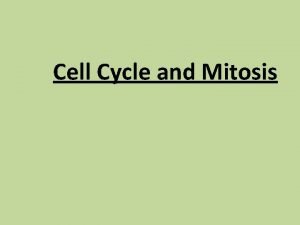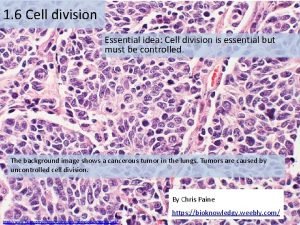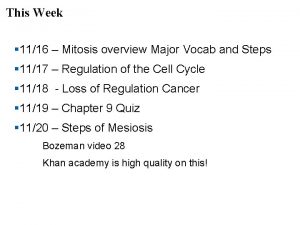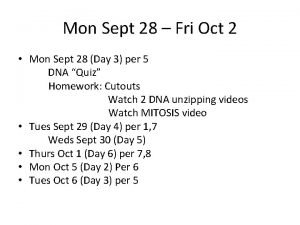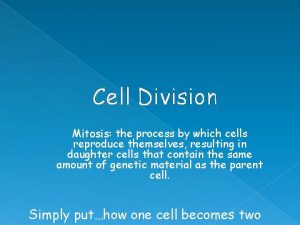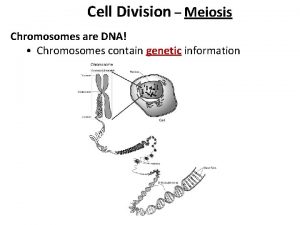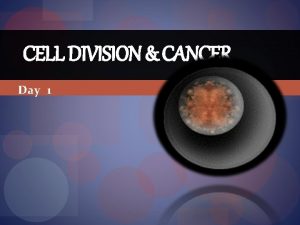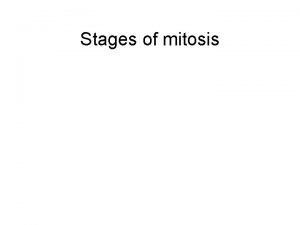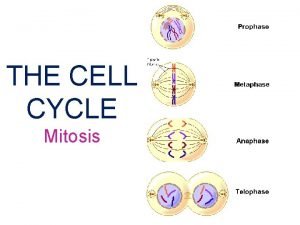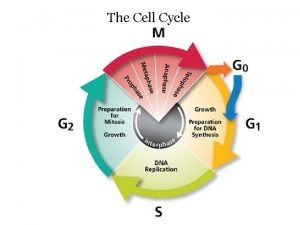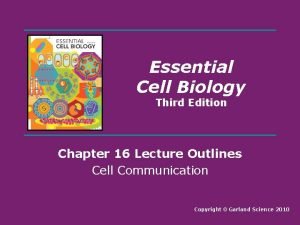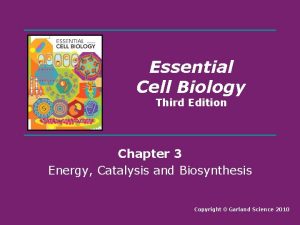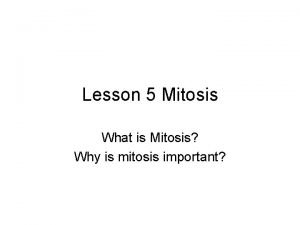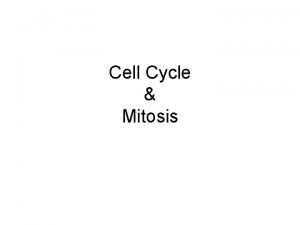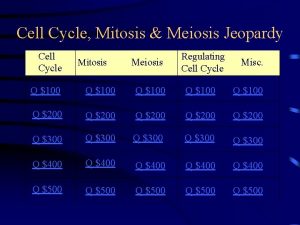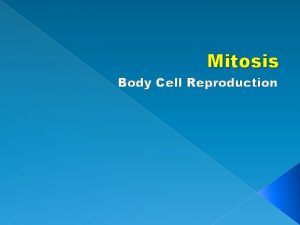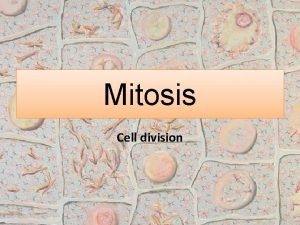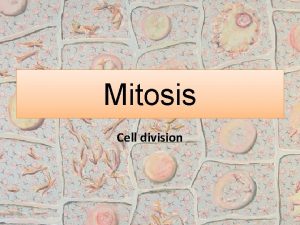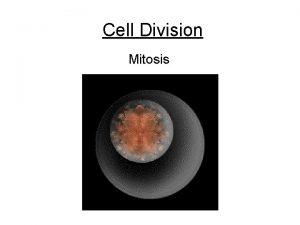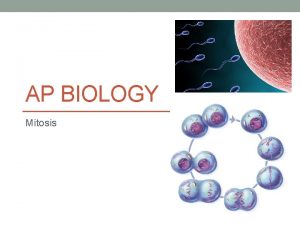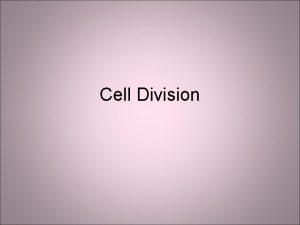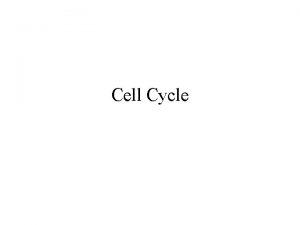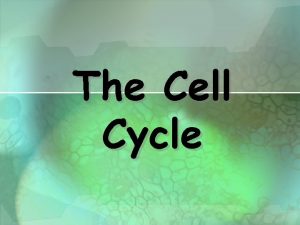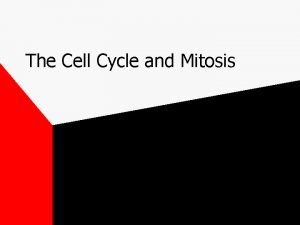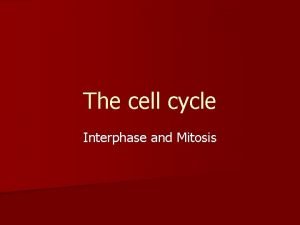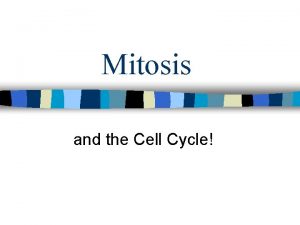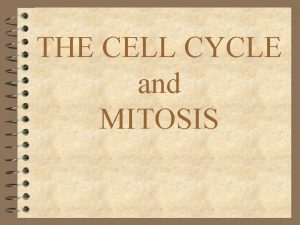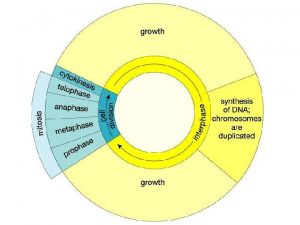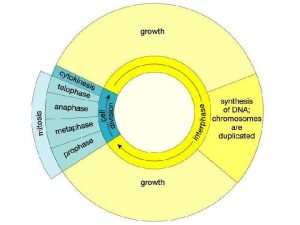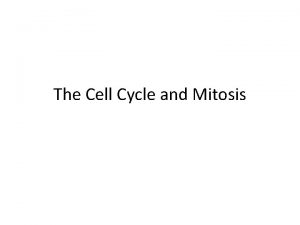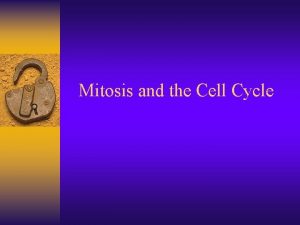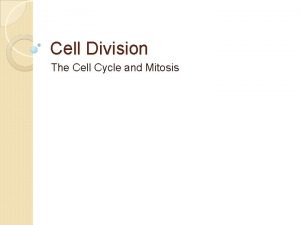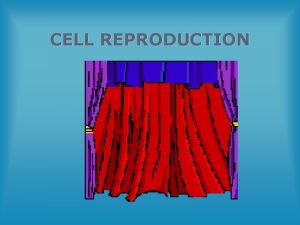Cell Cycle and Mitosis Essential Questions Why are




































- Slides: 36

Cell Cycle and Mitosis

Essential Questions • • • Why are cells relatively small? What are the primary stages of the cell cycle? What are the stages of interphase? Copyright © Mc. Graw-Hill Education Cellular Growth

Vocabulary Review New • • selective permeability Copyright © Mc. Graw-Hill Education cell cycle interphase mitosis cytokinesis chromosome chromatin Cellular Growth

The Cell Cycle • Once a cell reaches its size limit it must either stop growing or divide. • Cells reproduce by a cycle of growing and dividing called the cell cycle. • Each time a cell goes through one complete cycle, it becomes two identical cells. • Three main stages of the cell cycle: • Interphase: stage during which the cells grows, carries out cellular functions, and replicates its DNA. Longest stage of cell cycle. • Mitosis: the cell’s nucleus and nuclear material divide; has four substages. • Cytokinesis: cell’s cytoplasm divides, creating two new cells. Cellular Growth Copyright © Mc. Graw-Hill Education

The Cell Cycle The stages of interphase • Interphase has three substages: G 1, S, and G 2. • During G 1 (Gap 1), the cell is growing and carrying out normal cellular functions. Copyright © Mc. Graw-Hill Education Cellular Growth

The Cell Cycle The stages of interphase • During S (Synthesis Phase), the cell copies its DNA in preparation for cell division. • Chromosomes are the structures that contain the genetic material when it’s condensed and tightly packed • Chromatin is the decondensed, loosely packed, or relaxed form of DNA in the cell’s nucleus. Copyright © Mc. Graw-Hill Education Cellular Growth

The Cell Cycle The stages of interphase • The G 2 stage follows the S stage and is the period when the cell prepares for the division of its nucleus. Copyright © Mc. Graw-Hill Education Cellular Growth

The Cell Cycle Mitosis and cytokinesis • During mitosis, a cell’s nuclear material divides and separates into opposite sides of the cell. • During cytokinesis, the cell divides into two daughter cells. Copyright © Mc. Graw-Hill Education Cellular Growth

The Cell Cycle • Eukaryotic cells divide via mitosis. • Prokaryotic cells divide via binary fission. Copyright © Mc. Graw-Hill Education Cellular Growth

Review Essential Questions • • • Why are cells relatively small? What are the primary stages of the cell cycle? What are the stages of interphase? Vocabulary • • cell cycle interphase Copyright © Mc. Graw-Hill Education • • mitosis cytokinesis • • chromosome chromatin Cellular Growth

Essential Questions • What are the events of each stage of mitosis? • What is the process of cytokinesis? Copyright © Mc. Graw-Hill Education Mitosis and Cytokinesis

Vocabulary Review New • • life cycle Copyright © Mc. Graw-Hill Education prophase sister chromatid centromere spindle apparatus metaphase anaphase telophase Mitosis and Cytokinesis

Mitosis • During mitosis cell’s replicated genetic material separates and the cell prepares to split into two cells. • The key activity of mitosis is the accurate separation of the cell’s replicated DNA. • What’s the purpose of mitosis? : • Increases the number of cells in a multicellular organism as it grows • Replaces damaged cells Copyright © Mc. Graw-Hill Education Mitosis and Cytokinesis

The Stages of Mitosis Prophase • Prophase is the first and longest stage of mitosis. • Cell’s chromatin tightens/condenses into chromosomes. • Sister chromatids are structures that contain identical copies of DNA. • The sister chromatids are attached at the centromere. Copyright © Mc. Graw-Hill Education Mitosis and Cytokinesis

The Stages of Mitosis Prophase • As prophase continues, spindle fibers, centrioles, and aster fibers form a spindle apparatus. • The spindle apparatus attaches to each of the sister chromatids before cell division. Copyright © Mc. Graw-Hill Education Mitosis and Cytokinesis

The Stages of Mitosis Metaphase • The second stage of mitosis is metaphase – the shortest phase. • Sister chromatids are pulled along the spindle apparatus toward the center of the cell. • They line up in the middle of the cell. Copyright © Mc. Graw-Hill Education Mitosis and Cytokinesis

The Stages of Mitosis Anaphase • During anaphase, the chromatids pull apart. • The microtubules of the spindle apparatus begin to shorten. • The sister chromatids separate. • The chromosomes move toward the poles of the cell. Copyright © Mc. Graw-Hill Education Mitosis and Cytokinesis

The Stages of Mitosis Telophase • Telophase is when the chromosomes arrive at the poles and begin to decondense. • Two new nuclear membranes begin to form and the nucleoli reappear. • The spindle apparatus disassembles. Copyright © Mc. Graw-Hill Education Mitosis and Cytokinesis

Cytokinesis • After the two daughter nuclei have formed, cells undergo cytokinesis. • In animal cells, microfilaments constrict/pinch off to form two cells. • In plant cells, instead of pinching in half, a new structure called the cell plate forms between the two daughter nuclei. Copyright © Mc. Graw-Hill Education Mitosis and Cytokinesis

Identical Daughter Cells Two identical daughter cells Parent Cell 20

Mitosis

Review Essential Questions • What are the events of each stage of mitosis? • What is the process of cytokinesis? Vocabulary • • • prophase sister chromatid centromere Copyright © Mc. Graw-Hill Education • • spindle apparatus metaphase • • anaphase telophase Mitosis and Cytokinesis

Essential Questions • • What is the role of cyclin proteins in controlling the cell cycle? How does cancer relate to the cell cycle? What is the role of apoptosis? What are the two types of stem cells and what are their potential uses? Copyright © Mc. Graw-Hill Education Cell Cycle Regulation

Vocabulary Review New • • nucleotide Copyright © Mc. Graw-Hill Education cyclin-dependent kinase cancer carcinogen apoptosis stem cell Cycle Regulation

Factors Influencing the Cell Cycle, & Causes of Cancer.

Normal Cell Cycle The role of cyclins • The timing and rate of cell division are important, and controlled by proteins and enzymes • The cell cycle in eukaryotic cells is driven by a combination of two substances. • Cyclins are proteins that bind to enzymes called cyclindependent kinases (CDKs). • Different cyclin/CDK combinations control different activities during different stages of the cell cycle. Copyright © Mc. Graw-Hill Education Cell Cycle Regulation

Normal Cell Cycle Quality control checkpoints • The cell cycle has built-in checkpoints that monitor the cycle and can stop it if something goes wrong. • There are checkpoints after each stage of interphase to protect against duplicating DNA damage. Copyright © Mc. Graw-Hill Education Cell Cycle Regulation

Go Phase: Resting Phase of the Cell Cycle • Go phase: Is the resting phase of the Cell Cycle • The Cell is no longer growing and the cell is not preparing to replicate DNA. • Just a state where the cell is kind of turn off from any sort of development.

Abnormal Cell Cycle: Cancer • Cancer is the uncontrolled growth and division of cells. • Cancer results when cells stop responding to the controls of the cell cycle. • Cancer cells can kill an organism by crowding out normal cells, resulting in the loss of tissue function. Copyright © Mc. Graw-Hill Education Cell Cycle Regulation

Abnormal Cell Cycle: Cancer Causes of cancer • Mutations or changes in segments of DNA cause the cell growth and division of cancer cells. • Various environmental factors can affect the occurrence of cancer cells. • Substances that are know to cause cancer are called carcinogens. Copyright © Mc. Graw-Hill Education Cell Cycle Regulation

Reproduction: Prokaryotes vs Eukaryotes

Apoptosis • Apoptosis is the process of programmed cell death. • Cells going through apoptosis shrink and shrivel. • Apoptosis occurs during development, in cells that are damaged, and in cells that may lead to cancerous growths. Copyright © Mc. Graw-Hill Education Cell Cycle Regulation

Stem Cells • • Multicellular organisms have specialized cells. The precursor cells that can be directed to become specialized cells are stem cells. Copyright © Mc. Graw-Hill Education Cell Cycle Regulation

Stem Cells Embryonic stem cells • • After fertilization, the initial mass of cells (100 -150 cells) remain undifferentiated – these comprise embryonic stem cells. As development continues, cells receive signals that initiate their differentiation into specialized cells. Copyright © Mc. Graw-Hill Education Cell Cycle Regulation

Stem Cells Adult stem cells • • • Found in various tissues in the body Might be used to maintain and repair tissue. More developed/specialized than embryonic stem cells, but might be able to differentiate into different kinds of cells. Copyright © Mc. Graw-Hill Education Cell Cycle Regulation

Review Essential Questions • • What is the role of cyclin proteins in controlling the cell cycle? How does cancer relate to the cell cycle? What is the role of apoptosis? What are the two types of stem cells and what are their potential uses? Vocabulary • • cyclin-dependent kinase Copyright © Mc. Graw-Hill Education • • cancer carcinogen • • apoptosis stem cell Cycle Regulation
 Antigentest åre
Antigentest åre Mitosis essential questions
Mitosis essential questions Mitosis and cell cycle terminology
Mitosis and cell cycle terminology Mitosis meiosis concept map
Mitosis meiosis concept map Cell cycle mitosis
Cell cycle mitosis Pictures
Pictures Cell cycle and cell division
Cell cycle and cell division Cell cycle and cell division
Cell cycle and cell division Water cycle essential questions
Water cycle essential questions Kesler science rock cycle answer key
Kesler science rock cycle answer key Painting
Painting Biology.arizona.edu/cell bio/activities/cell cycle/01.html
Biology.arizona.edu/cell bio/activities/cell cycle/01.html Characteristics of lipids
Characteristics of lipids Mitosis meiosis
Mitosis meiosis Two cells are produced
Two cells are produced Don't ask why why why
Don't ask why why why Onion cell mitosis labeled
Onion cell mitosis labeled Mitosis number of cell divisions
Mitosis number of cell divisions Number of chromosomes in meiosis
Number of chromosomes in meiosis Cell mitosis
Cell mitosis Interphase
Interphase Mitosis
Mitosis Bone cells mitosis
Bone cells mitosis Mitosis bingo
Mitosis bingo When do spindle fibers first become visible brainpop
When do spindle fibers first become visible brainpop Cell biology
Cell biology Essential cell biology
Essential cell biology What are enduring understandings
What are enduring understandings Weathering and erosion essential questions
Weathering and erosion essential questions Romeos friend
Romeos friend What was billy weaver doing in the city of bath
What was billy weaver doing in the city of bath Cancer is mitosis gone wild
Cancer is mitosis gone wild Why is mitosis important?
Why is mitosis important? Advantages of diaphragm cell
Advantages of diaphragm cell Prokaryotic and eukaryotic cells
Prokaryotic and eukaryotic cells Plant cell animal cell venn diagram
Plant cell animal cell venn diagram Vacuole function
Vacuole function

